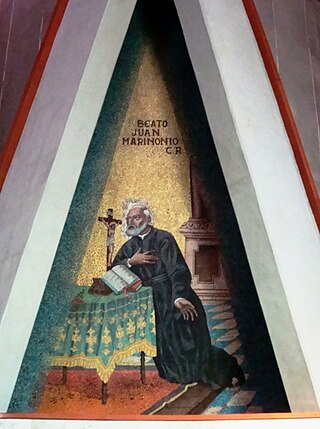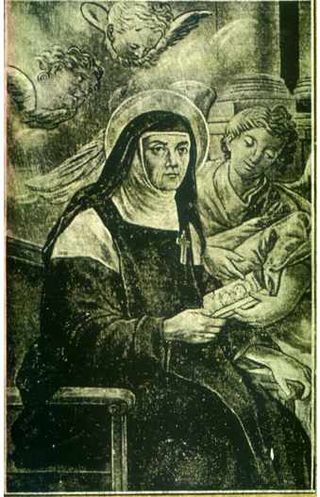Related Research Articles
Jaime Hilario Barbal, FSC was a Spanish Catholic and professed Brother of the Christian Schools. He served for almost two decades as a teacher in the schools that his order managed until being caught up in the turmoil of the Spanish Civil War, which saw the forces of the Second Spanish Republic execute him.

María de la Purísima Salvat Romero, born María Isabel Salvat Romero, was a Spanish Roman Catholic nun and a member of the Sisters of the Company of the Cross. She assumed the name of "María de la Purísima of the Cross" after she entered that order. Romero was the successor of Angela of the Cross of the latter's congregation and was known for her firmness in the progress of the order and in their role as servants of God and His people. Romero was known in her order for her strong commitment to uphold the magisterium of the Church.

Mateo Elías Nieves Castillo was a Mexican Roman Catholic priest who was also a member of the Order of Saint Augustine who assumed the name of Elias del Socorro when he became a member of the order.

Francesco Marinoni was an Italian Roman Catholic priest who was a member of the Theatines. He assumed the name Giovanni upon his admittance into the order.
Giovanni Battista Mazzucconi was an Italian priest from the Pontifical Institute for Foreign Missions. He was killed in hatred of the faith in Papua New Guinea during his work there amongst the people.
Pedro Asúa Mendía was a Spanish Roman Catholic priest and engineer. He studied under the Jesuits and he trained also as an architect. He graduated in that field in 1915. He worked on schools and houses for religious across Spain where he served as a priest. He was killed in hatred of his faith during the Spanish Civil War.

Marcel Callo was a French Roman Catholic from Rennes who served in Catholic organizations – in particular the Young Christian Workers (Jocists) – devoted to charitable works to the poor and to communities in general. Callo served as an apprentice at a print store from the age of thirteen before joining Catholic associations in France. He was conscripted to serve during World War II and the Gestapo arrested him in 1944 for his Christian activities. He died in the camps after being forced to do long hours of labour.

Marguerite Rutan was a French Roman Catholic religious person who was a professed member of the Vincentian Sisters. Rutan served as the mother superior of a hospital the sisters managed until the time of the French Revolution when she was executed based on the allegations of fanaticism and anti-Revolution sentiment.

Salomon Leclercq – born Guillaume-Nicolas-Louis Leclercq – was a French religious brother. Leclercq assumed the religious name Salomon after he made vows in the Institute of the Brothers of the Christian Schools.

Juana María Condesa Lluch was a Spanish religious sister who established the Handmaids of Mary Immaculate in her hometown of Valencia. She made her vows in 1911.

Inés de Benigánim, religious name Josefa María of Saint Agnes, - born as Josefa Teresa Albiñana Gomar - was a Spanish nun of the Discalced Augustinians. She became known for her profound spiritual and theological insight as well as for her severe austerities she practiced during her life. Her beatification was celebrated in 1888 in Saint Peter's Basilica.

Darío Acosta Zurita was a Mexican Roman Catholic priest who administered in Veracruz where he lived and was killed. Zurita commenced his studies for the priesthood after he had once been refused entrance and he became known as an athletic seminarian. Bishop Rafael Guízar Valencia ordained him in 1931 and he was killed three months later after armed gunmen stormed the cathedral – enacting the so-called Tejeda Law – and shot him dead.

The Martyrs of Tlaxcala were three Mexican Roman Catholic teenagers from the state of Tlaxcala: Cristobal (1514/15–1527) and the two companions Antonio (1516/17–1529) and Juan (1516/17–1529). The three teenagers were converts from the indigenous traditions of their families to the Roman Catholic faith and received their educations from the Order of Friars Minor who baptized them and evangelized in the area. Their activism and evangelical zeal led to their deaths at the hands of those who detested their newfound faith and recognized them as dangers to their values and rituals.

The Martyrs of Natal were a group of 30 Roman Catholic people of Colonial Brazil – two of them priests – killed in the northern part of the colony in massacres that a large group of Dutch Calvinists led. One priest was a Colonial Brazilian Jesuit missionary, while the other priest was an evangelizer himself. The others were all lay Catholics, most of them anonymous members of the Church, some of them children.
Antonio Pavoni, OP was an Italian Catholic priest and member from the Order of Preachers. He served as an inquisitor-general for Pope Urban V in combatting Waldensians in the Lombard region, but the Waldensians succeeded in killing him in an ambush as he preached an Eastertide homily in 1374.

Juan de Prado, OFM was a Spanish Roman Catholic priest and a professed member from the Order of Friars Minor. He served as part of the missions in Muslim Morocco at the request of Pope Urban VIII and brought much solace to the small Christian population there before the ruler had him murdered.
María Francisca Ricart Olmos, religious name María Guadalupe, was a Spanish nun of the Servite Order. Ricart's call to the religious life manifested at the time she made her First Communion after expressing the desire to consecrate herself to God; she entered the convent when she turned fifteen and served her convent as both a prioress and mistress of novices. Her peers held her in high regard for her dedication to helping and instructing the novices] as well as for her compassionate and jovial character.

Mariano Mullerat i Soldevila was a Spanish Roman Catholic doctor who also served as the mayor for Arbeca from 1924 until March 1930. Mullerat studied medicine in Reus and Barcelona before he married in 1922 and settled with his wife in Arbeca where he pursued his private medical practice. He was a staunch Catholic traditionalist who defended Catholic dogma from liberalist interpretations and as a doctor provided free care for the poor and would even help them with their material needs. In his tenure as mayor he helped organize religious solemnities and was also known to pursue those who made blasphemous claims and slander in public.
Victor Emilio Moscoso y Cárdenas was an Ecuadorian Roman Catholic priest and professed member from the Jesuits. He served as a teacher in the COPEM college in Riobamba since 1892 and it was there that he was slain during the Liberal Revolution which had started in 1895. Moscoso was a noted philosopher and taught rhetoric and grammar to his students while serving as a professor; he also served as the college's rector from 1893 until his assassination.
Vicente Garrido Pastor was a Spanish Roman Catholic priest and the founder of the Secular Institute of the Workers of the Cross. Garrido served as a parish priest and teacher before becoming the canon for the Valencia Cathedral where he often spent long hours listening to confessions. He was also a sought after spiritual director with priests and married couples going to see him for consultation. Garrido founded his order in 1934 with the aim of Christian sanctification for all people with a particular emphasis on the role of women in the Church.
References
- 1 2 3 4 5 "Blessed Vicente Vilar David". Saints SQPN. 10 August 2015. Retrieved 20 February 2016.
- 1 2 3 "Blessed Vicente Vilar David". Santi e Beati. Retrieved 20 February 2016.
- ↑ "Biographies of New Blesseds - 1995". EWTN. Retrieved 20 February 2016.